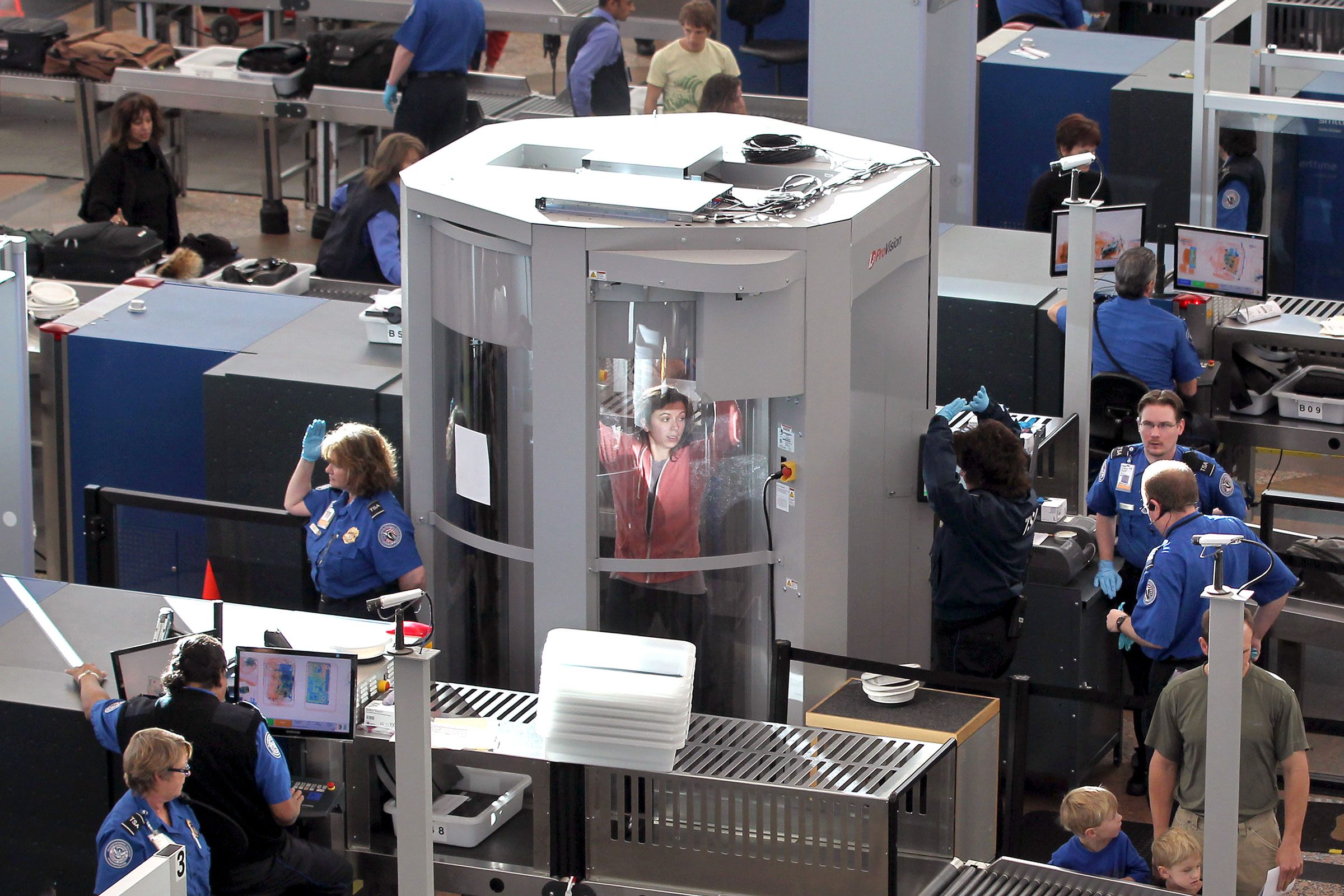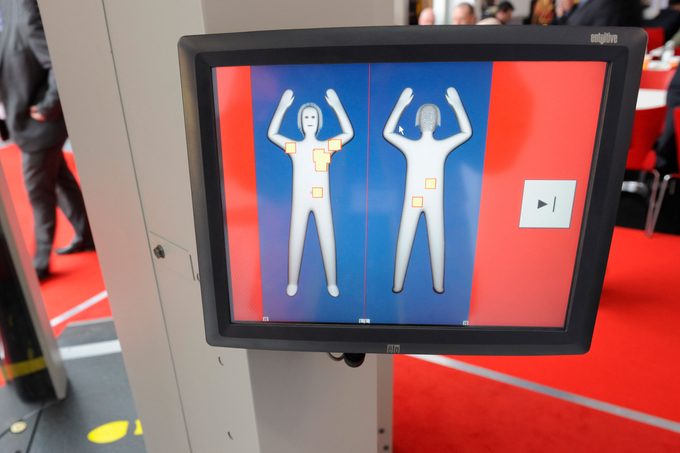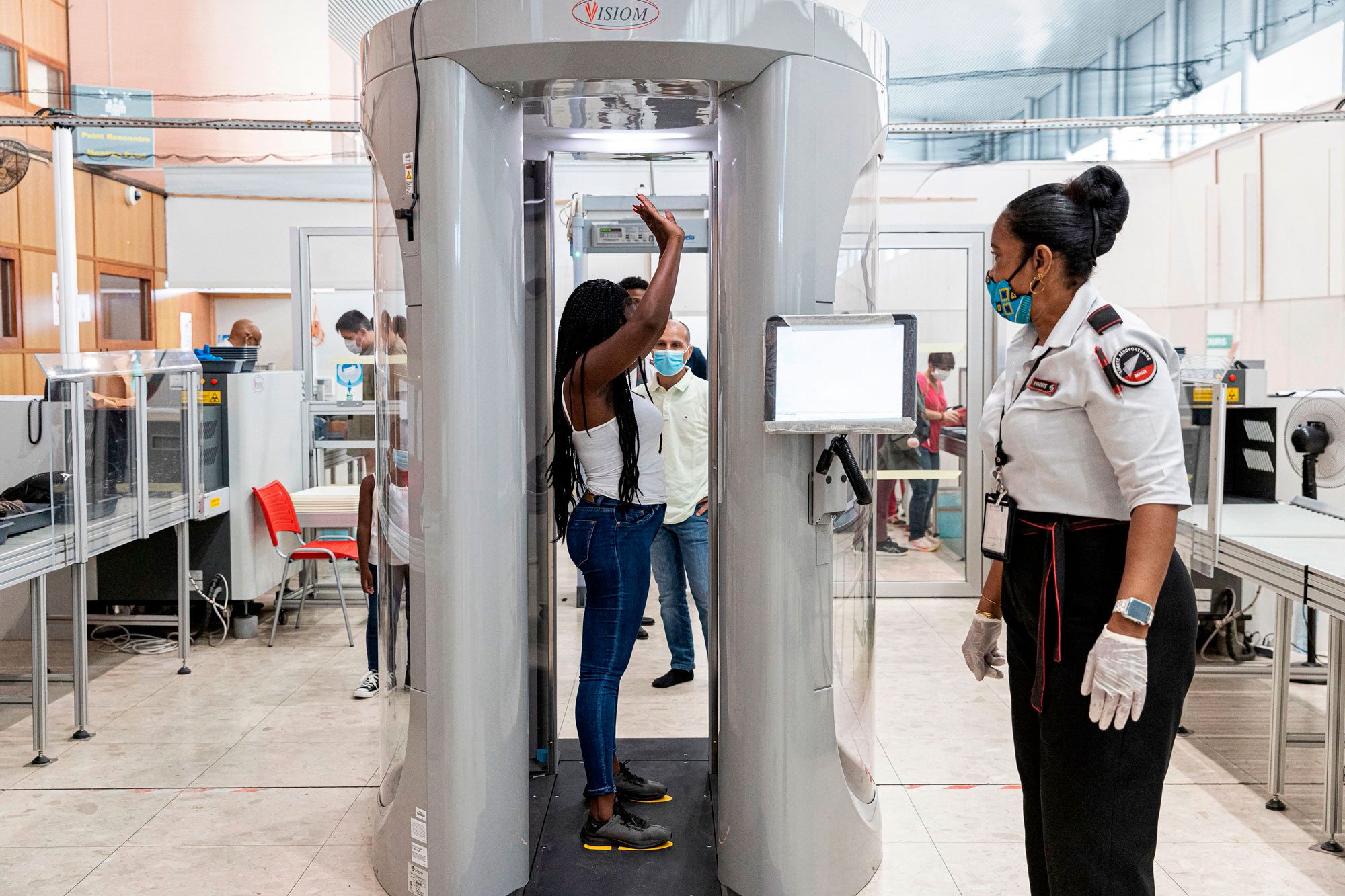Sure, airport body scanners are looking for threats, but here’s what else these security devices might reveal in the process

What Do Airport Body Scanners Really See?

Gone are the days when friends and family could walk you to your gate and you could board an airplane without a detailed airport security check. (For you youngsters, yes, that actually happened once upon a time.) Now, of course, you have to worry about long security lines and complicated TSA carry-on rules. And then there are the metal detectors, facial scanners and body scanners. You know those machines are there for your safety, but they still may give you pause—especially the body scanner. After all, what do airport body scanners see, exactly? Can TSA agents see you naked?
Those are valid questions. The new machines may also make you wonder if they’re safe or exposing you to dangerous rays. And is it possible to skip them altogether if you sign up for TSA PreCheck? We spoke to airport-security experts and a former TSA agent (officially called a “transportation security officer,” or TSO) to get the lowdown on airport body scanners so you know exactly what to expect the next time you head to the airport.
Ahead, you’ll learn how body scanners work, whether they’re safe and what workers can see—straight from the TSA itself.
Get Reader’s Digest’s Read Up newsletter for more travel, tech, cleaning, humor and fun facts all week long.
How do body scanners work?
Before we answer the question “what do airport body scanners see,” we need to discuss how they work. What happens when you step into the machine, place your feet on the footprints and put your arms over your head? “Body scanners use a technology called Advanced Imaging Technology (AIT) for full-body scans at airport checkpoints,” explains TSA spokesperson R. Carter Langston. “It’s a millimeter wave scanner that detects a wide range of metallic and nonmetallic threats in a matter of seconds.”
While there’s a lot of complicated science behind that millimeter wave imaging, here’s the gist: “Essentially, the machines send millimeter waves toward a passenger’s insides,” explains Shawna Malvini Redden, PhD, the author of 101 Pat-Downs and a communication researcher who has studied the TSA since 2010. “The waves go through clothing and reflect off the passenger’s skin (and whatever else is concealed) and bounce back an image, which is interpreted by the machine.”
If the electromagnetic waves hit something that seems suspect, a TSO will investigate further. But if not, says Langston, you can pass right through the security checkpoint without a pat-down or other physical contact. If you have something you shouldn’t, the item will be confiscated by the TSA—and could possibly land you in some hot water.
What do airport body scanners see?
Nothing detailed or X-rated. “The body scanners provide a nondescript avatar image of the human anatomy,” says Eri Jenkins, an advisor who previously worked in uniform at a TSA checkpoint. “Images reveal items that might be on skin or inside clothing.” This generic human form, which looks kind of like a gingerbread man or paper doll, is used “to ensure passenger privacy while maintaining security effectiveness,” Langston says. Body scanners are looking for items that could be potential threats; they’re not looking at your physical body.
“With millimeter wave machines that have the privacy software installed, TSOs are only seeing this outline with a green ‘clear’ or a red ‘stop and check’ signal,” Malvini Redden explains. “If someone has something in their pockets, for instance, the machine will put an alarm note in the paper doll’s groin region so the officer knows generally where to search.” Plus, nothing will be hidden from your view—you can see everything the TSOs see on the screen. “Passengers are able to see the viewing monitor throughout the process,” Jenkins says.
Just make sure you clear out your pockets like you’re supposed to. “Benign undivested items” are also picked up by the AIT, which is why it’s worth thinking about what to wear on a plane. What are benign undivested items? Those are the things we are required to put in the bins before walking through security checkpoints but often accidentally forget about, such as:
- Watches
- Keys
- Belts
- Coins
- Jewelry
- IDs
- Phones
These will set off the airport scanner’s sensors, and you may be pulled aside for a more detailed check. If you have anything on your body that you think will set off the alarms, such as a medical device, let the TSO know before you go through the machine.
Do airport body scanners see you naked?

No. An airport scanner doesn’t show your naked body on its screen … anymore. “Early versions of the scanners came out without any privacy protections, and TSOs could be looking at naked images of passengers as they went through the screening,” explains Malvini Redden. But even with these old machines, which used backscatter technology, the TSA implemented some safeguards for passenger privacy, albeit not enough: The officer at the checkpoint wasn’t the same one who saw you on the screen. “With older machines that are no longer used in checkpoints, officers located in a remote area away from passengers could see under clothing,” Jenkins says. “To protect passenger identity, the remote officer was unable to see the identity of the passenger being screened. The remote officer would use radios to communicate the location of possible prohibited items.”
But because of privacy and health concerns, those machines were removed from all airports in 2013. “This technology has since been replaced, and an avatar ensures privacy for all passengers,” Jenkins says. Today’s millimeter wave machines don’t see nipples or genitalia, and they do not pick up size, weight or height.
“Now when passengers are scanned, the machines are supposed to generate generic images of a body instead of the passenger’s unique image,” Malvini Redden says. It’s literally just the outline of a body with a box representing the area where the scanner picked up something. In fact, according to the TSA, if there is no alarm, officers don’t see anything at all—simply a screen reading “OK.”
What are airport body scanners looking for?
Airport body scanners alert the TSO to threats, mainly weapons, or items in violation of the TSA carry-on rules that people may be trying to sneak onto planes. They are designed to detect “metallic and nonmetallic threat items,” according to the TSA. Jenkins adds: “In my experience, the body scanners catch metallic items and items that are not metallic but could evade the standard metal detectors, such as explosive materials and weapons that are not made of metal.”
This may include:
- Explosives under clothes
- Knives
- Guns
- Weapons made out of materials other than metal, like ceramics
What might accidentally set off a body scanner?
Aside from the items you’ve forgotten to put in the bin, there are a few unusual things that can cause a body scanner to come back with that dreaded red signal. According to Malvini Redden and Jenkins, they may include:
- Thick hair: The most contentious trigger is thick hair, especially if it’s in a braid or bun.
- Hair clips: If there are clips holding your hair, especially if your hair is thick, the alarm may go off.
- Body piercings: Any metal on your body can be a trigger.
- Wire supports in undergarments: You might want to leave the underwire bra in your checked luggage, since it can set off the machine.
- External tumors: Any large growths on your body might stand out to the scanner. But growths inside your body, such as fibroids, will not.
- Sweat: No, this isn’t because it violates the TSA liquid limit. (Eww!) “Perspiration is probably the weirdest thing that can set off the scanners,” Malvini Redden says. “It has to do with millimeter wave technology and how the waves bounce off water.” She adds that since these machines often generate false alarms like this, some countries, including France and Germany, have banned them.
Even things as innocuous as layered clothing, zippers and buttons can lead to alarms occasionally, says Jenkins. But if you do accidentally set off the scanner, it’s not a huge problem, although it may require a pat-down. “Many of these alarms are easily resolved,” Jenkins says.
Do body scanners really work?
Yes. According to Jenkins and Langston, body scanners are effective at spotting weapons. “It is a proven technology, and we are highly confident in its detection capability,” Langston says. “It has been widely accepted as an alternative to the full-body pat-down, which remains the alternative security screening protocol for those who refuse full-body security scanners.”
Malvini Redden notes, however, that they’re not infallible. The machines can malfunction, the alarms can go off without good reason, and they’re cumbersome and expensive. In short, she says, they “work to portray the appearance of taking security seriously,” but she questions just how effectively they actually do that.
Can you refuse to go through a body scanner?
Yes, you can refuse to go through an airport body scanner. Still, the machines are there for your safety, so you should always be polite about it, avoid being aggressive or rude, and do you best not to annoy TSA agents, especially since this might get you flagged as a disruptive or unruly passenger. “For the greater part, I think people want to understand their options and do not appreciate being forced into a decision,” Jenkins says. “Passengers have a right to ‘opt out’ and can receive another form of screening, like a pat-down screening.”
Just be aware, says Malvini Redden, of what a pat-down may involve. “A TSO will physically check your body from head to toe, possibly including an intimate check of breasts/groin/buttocks,” she says. And while you can request a private room for the screening, they’re typically done near the checkpoint.
Do you have to go through a body scanner if you have TSA PreCheck?
Yes. If you sign up for TSA PreCheck, you can skip some of the more onerous security processes like taking off your shoes, removing liquids from your carry-on and taking your laptop out of your bag, but you’ll still have to go through the body scanner, according to Langston. Some checkpoints may direct you to the full metal detector instead, though, says Malvini Redden.
Are full-body scanners safe?

According to the experts we spoke with, today’s body scanners are safe … but there was a time when they may not have been. Between 2009 and 2013, the TSA used Rapiscan backscatter machines, and there were concerns about safety (in addition to privacy and effectiveness). They produced a stream of low-energy X-rays, which people worried could increase radiation exposure. In 2010, pilot and flight-crew unions successfully lobbied to change the requirements to go through advanced imaging and avoid the excess radiation, says Malvini Redden. Flight attendants followed suit in 2012.
The newer AIT scanners utilized now, however, use millimeter wave imaging, which is a special type of microwave, not an X-ray. In fact, we’re exposed to this type of non-ionizing radiation every day at low levels, according to the Centers for Disease Control and Prevention (CDC). When exposure to non-iodizing waves is too high, a person may experience tissue damage (for example, UV rays from a sunburn or a tanning bed), but millimeter waves give off much less than this. Plus, non-iodizing waves are not as harmful as the ionizing radiation used once upon a time in airport body scanners.
Still, those who fly often may be concerned about being exposed to this on a regular basis. Should they be? Nope. “Passengers don’t have anything to worry about. The AIT scanners are safe,” Langston says. “And the energy emitted by millimeter wave technology is 10,000 times less than what is permitted by the standard cellphone.”
FAQs
Can airport body scanners see tampons?
This is a frequently asked question on Google, so we went straight to the TSA for an answer. “The body scanners cannot see anything inside of the body, including tampons or any other items,” Jenkins says. So if this is something you’re worried about, you can breathe a sigh of relief. Langston confirms: “Millimeter wave imaging technology does not detect items inside a passenger’s body or penetrate the skin.”
Do airport body scanners pick up drugs?
Given that body scanners don’t see under the skin, Malvini Redden says body scanners would also not pick up anything else stashed inside a body cavity, such as drugs or hazardous liquids. These items might be detected, however, if they were in your pockets.
Do children have to go through the body scanner?
Yes, airport rules require that children, including infants, go through the scanner, although you are allowed to carry them if they can’t walk. It’s safe for them. If the alarm goes off, TSA has put measures in place so the need for pat-downs is less. For example, they may allow children to go through again or try to figure out what’s setting off the alarm without touching them. Either way, children will not be separated from you.
About the experts
|
Why trust us
Reader’s Digest has published hundreds of travel stories that help readers explore the world safely, easily and affordably. We regularly cover topics such as the best places to visit (and the best times to visit them), tips and tricks to zoom through airport security, flight-attendant secrets, hotel-room hacks and more. We’re committed to producing high-quality content by writers with expertise and experience in their field in consultation with relevant, qualified experts. We rely on reputable primary sources, including government and professional organizations and academic institutions as well as our writers’ personal experiences where appropriate. We verify all facts and data, back them with credible sourcing and revisit them over time to ensure they remain accurate and up to date. Read more about our team, our contributors and our editorial policies.
Sources:
- Eri Jenkins, uniformed advisor for the TSA; email interview, Oct. 6, 2024
- R. Carter Langston, TSA spokesperson; email interview, 2022
- Shawna Malvini Redden, PhD, professor, communication researcher and author of 101 Pat-Downs; email interview, 2022
- TSA: “FAQ: Advanced Imaging Technology”
- TSA: “Travel Tips: Advanced Imaging Technology”
- U.S. Immigration and Customs Enforcement: “‘Underwear Bomber’ Umar Farouk Abdulmutallab sentenced to life”
- CNN: “TSA removes body scanners criticized as too revealing”
- ProPublica: “Sweating Bullets: Body Scanners Can See Perspiration as a Potential Weapon”
- CDC: “About Non-Ionizing Radiation”
- TSA: “Traveling with Children”






















